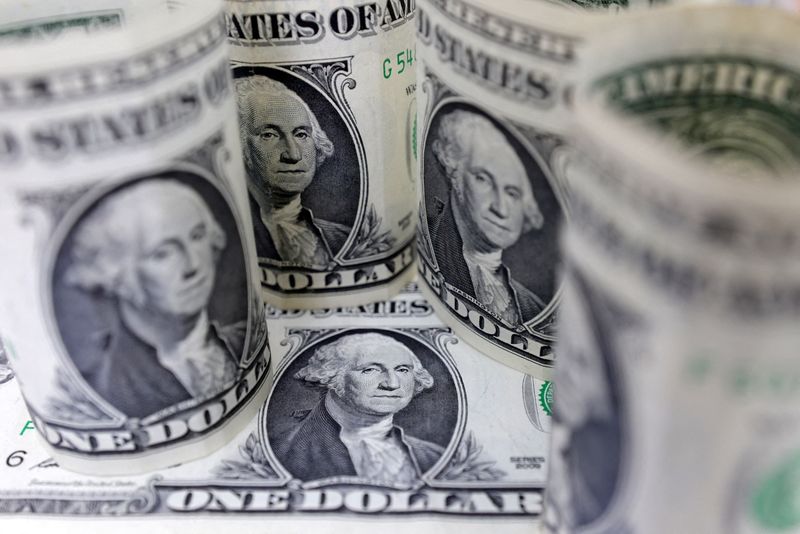Forex
Dollar gains before key inflation data

By Karen Brettell and Alun John
NEW YORK (Reuters) -The dollar gained on the euro on Thursday before key U.S. inflation data due on Friday and as investors squared positions for month- and quarter-end.
The Japanese currency was also modestly weaker at 151.38 per dollar having traded just shy of the 152 mark at its weakest since 1990 on Wednesday before Japan’s top monetary officials suggested they were ready to intervene to prevent further declines.
This week’s main U.S. economic focus is Personal Consumption Expenditures (PCE) data due on Friday, which will come after hotter than expected consumer and price inflation releases for January and February.
Traders will look for any new clues on whether the Federal Reserve remains on track to cut rates as soon as June as inflation remains sticky and economic growth stays strong.
Helen Given, FX trader at Monex USA, said that higher than expected inflation so far this year is unlikely to last, which should keep the Fed on pace for three 25 basis points cuts this year.
The dollar rallied earlier on Thursday following comments from Fed Governor Christopher Waller late on Wednesday that recent disappointing inflation data affirms the case for the U.S. central bank holding off on cutting its short-term interest rate target.
But Given said that move was “a little bit outsized and I think its really to do with the fact that there’s just slim flows across the world.”
U.S. Treasuries and stock markets will be closed for the Good Friday holiday and foreign exchange markets are likely to be lightly staffed, which may increase volatility.
Fed Chair Jerome Powell is also due to speak on Friday.
Data on Thursday showed that the U.S. economy grew faster than previously estimated in the fourth quarter, lifted by strong consumer spending and business investment in nonresidential structures such as factories.
The euro reached $1.0775, its lowest in five weeks, and was last down 0.34% at $1.0789. The pound weakened 0.15% to $1.262.
The rose 0.1% to 104.52, after earlier touching 104.73, its highest since mid-February.
INTERVENTION WATCH
Should the inflation data on Friday surprise on the upside and support the dollar, its most dramatic impact could be on the yen. Market participants say there is a dense thicket of options restricting moves in dollar/yen around the 152 level, and so a breakthrough could trigger more significant moves.
“Once dollar/yen touches 152, I think there will probably be a sharp move upward, and that’s when intervention could take place,” Takeshi Ishida, a currency strategist at Resona Holdings, said.
Japanese authorities held a meeting on Wednesday on the currency’s weakness and ramped up their verbal warnings, putting the market on the lookout for any signs that words are being backed up with action.
Japanese Prime Minister Fumio Kishida also said on Thursday the government will not rule out any options in addressing excessive moves in the currency market, stressing Tokyo’s resolve to step into the market if it sees the yen’s fall as overdone.
“Each time that currency officials in Japan have talked about this, it’s had less and less of an impact on yen pricing,” Given said. “Because of that we are now looking at a real tangible intervention risk.”
Japan intervened in the currency market three times in 2022, selling the dollar to buy yen, first in September and again in October as the yen slid towards a 32-year low of 152 to the dollar.
A summary of opinions at the Bank of Japan’s March meeting released last Thursday gave the currency little support, showing many policymakers saw the need to go slow in phasing out ultra-loose monetary policy.
Meanwhile, China’s central bank set the yuan fixing at the widest gap against Reuters’ estimate in nearly five months, as authorities step up efforts to prevent sharp declines in the currency. The yuan slumped to a four-month low last Friday. CNY/
The was mostly flat at 7.2256 per dollar, while offshore it weakened to 7.2615 per dollar.

The Australian dollar fell as low as $0.6486, the weakest since March 5. As well as being hurt by Waller’s remarks, data from Australia showed retail sales came in below economists’ expectations in February. AUD/
In cryptocurrencies, bitcoin gained 2.91% to $70,848.75.

 Forex3 years ago
Forex3 years agoForex Today: the dollar is gaining strength amid gloomy sentiment at the start of the Fed’s week

 Forex3 years ago
Forex3 years agoUnbiased review of Pocket Option broker

 Forex3 years ago
Forex3 years agoDollar to pound sterling exchange rate today: Pound plummeted to its lowest since 1985

 Forex3 years ago
Forex3 years agoHow is the Australian dollar doing today?

 Cryptocurrency3 years ago
Cryptocurrency3 years agoWhat happened in the crypto market – current events today

 World3 years ago
World3 years agoWhy are modern video games an art form?

 Commodities3 years ago
Commodities3 years agoCopper continues to fall in price on expectations of lower demand in China

 Economy3 years ago
Economy3 years agoCrude oil tankers double in price due to EU anti-Russian sanctions





















